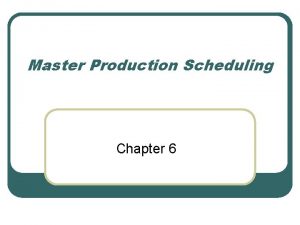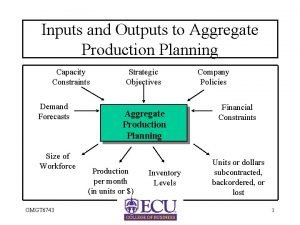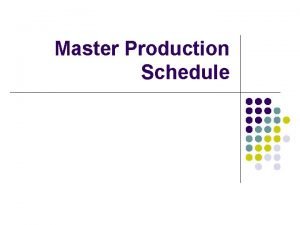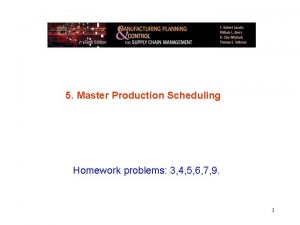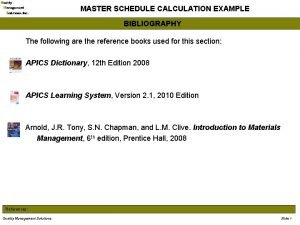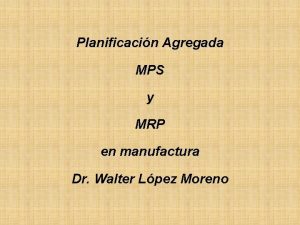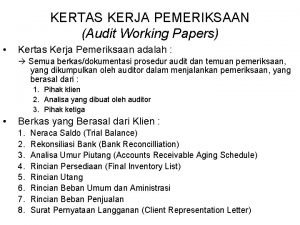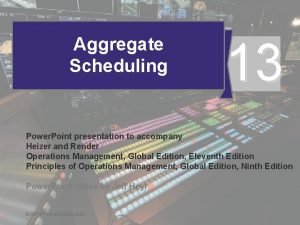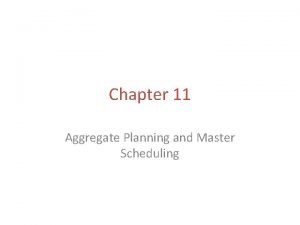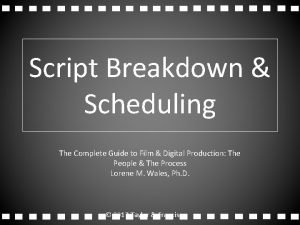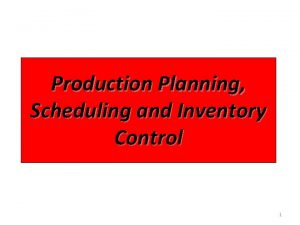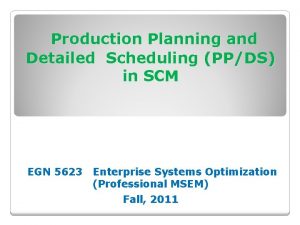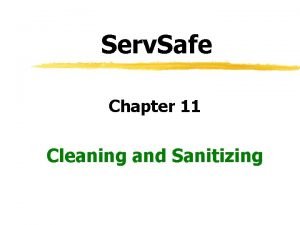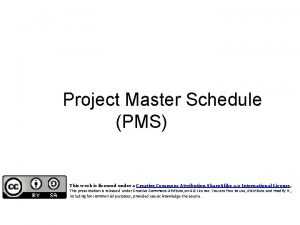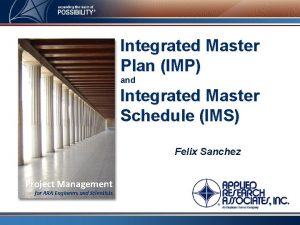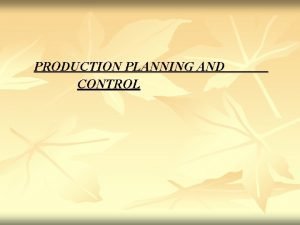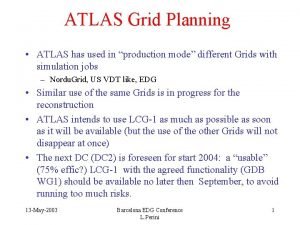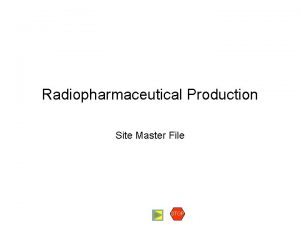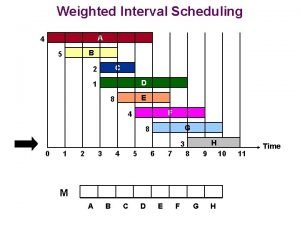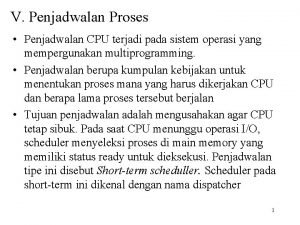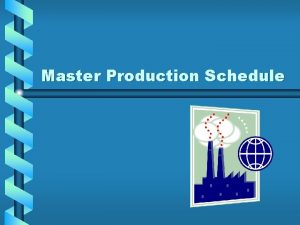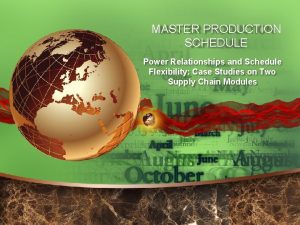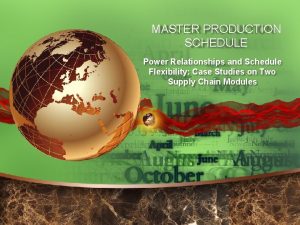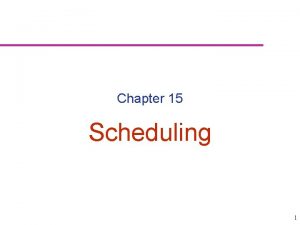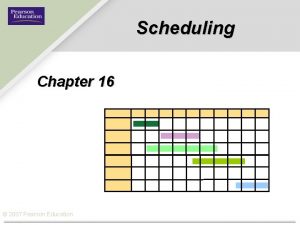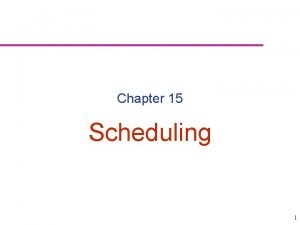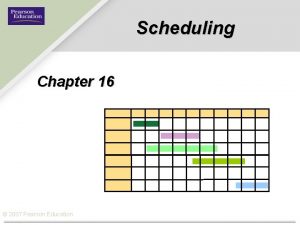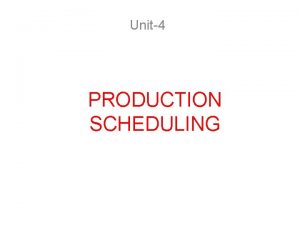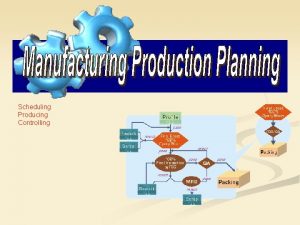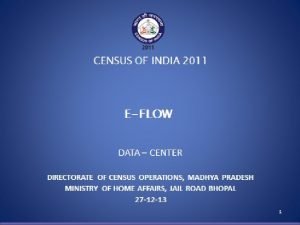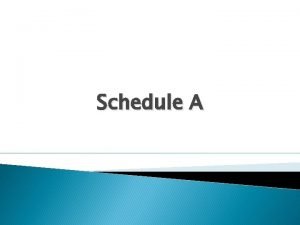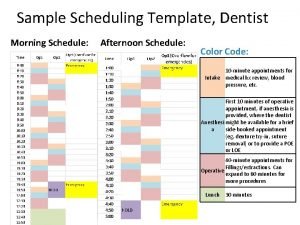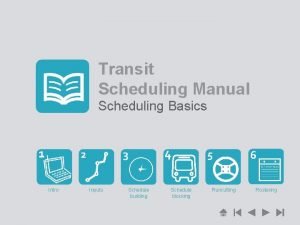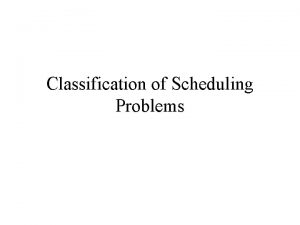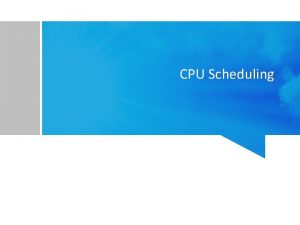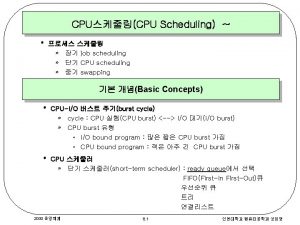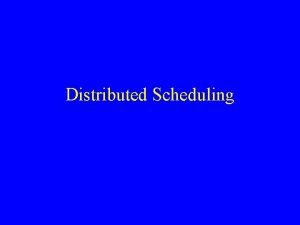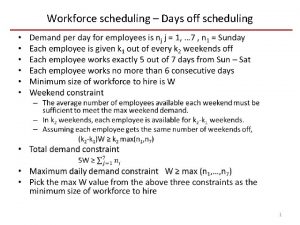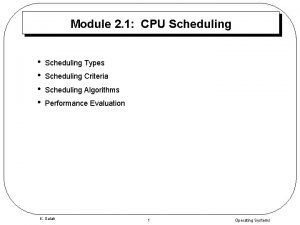Master Production Scheduling Chapter 6 Master Production Schedule
























- Slides: 24

Master Production Scheduling Chapter 6

Master Production Schedule l A master production schedule (MPS) is a production plan (anticipated build schedule) for an individual product, a customer order, or a product option and common parts • Make-to-stock: finished product • Make-to-order: customer order • Assemble-to-order: product option and common parts

MPC System

Master Production Scheduling l Effective MPS provides the basis for: ØMaking customer delivery promises ØUtilizing plant capacity effectively ØAttaining firm’s strategic objectives (from production plan) ØResolving trade-offs between production and marketing

MPS Activities l l Operational level—processing MPS transactions, maintaining MPS records and reports, having a periodic review and update cycle (“rolling through time”), responding to exception conditions, and measuring effectiveness of schedules Daily basis—marketing and production coordinate through order promising (shipment date for a customer order)

MPS Techniques—Time-Phased Record l Record (by periods) § Forecast § Available: projected inventory balance at the end of the period. [available from prior period + MPS – forecast] § MPS: quantity and time of completion of production § On hand: beginning inventory for the first period.

MPS Techniques—Time-Phased Record l Strategies: • Leveling: MPS constant. Excess inventory to meet future forecasts • Chase: MPS matches forecast. No inventory except safety stock • Mixed (hybrid): lot-sizing approach that falls between the two strategies. Inventory for future periods called cycle stock

MPS Techniques—Rolling through Time l MPS is periodically updated—changes in forecast, orders, production, etc. , may require adjustments for future periods l One “pointer” would be negative available balances l A counter-balancing force would be feasibility of change

MPS Techniques—Order Promising l l l Available-to-promise: deduct existing booked orders from available inventory. (See Figures 6. 8, 6. 9, 6. 10) Time-phased MPS record convention—use the greater of forecasts or booked orders to calculate available inventory balance. Accurate order promising helps a firm to reduce inventory by using buffer delivery promise dates instead.

MPS Techniques—Consuming the Forecast l Forecast estimates versus actual booked orders. l Negative Available—need a MPS lot (if feasible). l ATP calculated by using only actual orders and scheduled production. l Use both available and ATP rows for MPS planning: negative available quantities represents a “potential” problem, but a negative ATP is a real problem.

BOM Structuring for the MPS l l BOM—engineering document specifying subordinate components. • Single-level BOM. • Indented BOM. Assemble-to-order may represent almost unlimited number of end items (options multiply), leading to other BOM options for MPS planning.

Modular Bill of Materials l Establish the MPS at option or module level. BOM links options/modules to components but not to end items. Not Buildable. l MPS can be stated in fewer units. • Hill-Rom example (p. 231): 160 end item possibilities, but only 19 time-phased MPS records needed. l Customer order—a unique end item.

Planning Bill of Materials l l l Planning Bill: Created expressly forecasting and master scheduling Unique configuration, not buildable Store in BOM file Revise with engineering changes Phantom Bill: A bill for a subassembly whose components are consumed during the assembly of its parents

Super Bill of Materials l Super bill: describes the options or modules that make up an average end item. • Is used as the MPS unit: the plan would be to build per the average option proportions. l Adds complexity to order entry (ATP logic must be applied to each option in the order).

Final Assembly Schedule (FAS) l States exact set of end products to be produced over give time period (final assembly lead time). l MPS—anticipated build schedule; FAS is actual build schedule. In assemble-to-order MPS stated in super bills and options, FAS stated in end items per customer order. l Hill-Rom example, Figures 6. 16 -6. 19.

Master Production Scheduler (Master Planner) l Consolidate all sources of requirements – forecasts, customer orders, interplant orders, service parts orders, etc. l Carefully evaluate MPS changes to see effect on material and capacity plans. (Resolving competing demands. ) l Issue production and assembly orders.

Master Production Scheduler (Master Planner) l Understand trade-offs between customer needs and MPC system objectives. l Resolve conflict on production requirements among functions. l Report performance and problems to top management.

MPS Stability l Firm planned orders—quantity, timing are set by the master planner, not adjusted automatically by the software. l Frozen time periods—no changes in the stated time periods are possible. l Time fencing—specify periods in which differing types of changes are possible (e. g. , ice, slush, water zones)

Managing the MPS and Data Base l MPS Data Base • Maintain data integrity • Define clear functional responsibilities • Proper control of changes to BOM l Have a realistic MPS; do not overstate the MPS

Managing the MPS and Data Base l Stability and proper buffering l Force the sum of the MPS’s to equal the production plan. l Measures: § Output/period (dollars or units) vs. the MPS or the budget. § Customer service (hitting order acknowledgement or promise dates).

Concluding Principles l The MPS should reflect the company’s approach to the business environment in which it operates. l The MPS is one part of an MPC system—the other parts need to be in place as well for a fully effective MPS system. l Time-phased MPS records should incorporate useful features of standard MRP record processing.

Concluding Principles l Customer order promising activities must be closely coupled to the MPS. l Available-to-promise information should be provided to both the master planner and the sales department. l A final assembly schedule (FAS) should be used to convert an anticipated build schedule (MPS) into an actual build schedule.

Concluding Principles l The master planner must keep the sum of the parts (MPS) equal to the whole (production plan). l The MPS activities must be clearly defined in an organization. l Firm planned orders can be used in the MPS. l Stability should be designed into the MPS. l The MPS should be evaluated with a formal performance measurement system.

Chapter 6 Assignments l Problems 6. 4, and 6. 12 a & b, and 6. 14 l Due Tuesday, Sept. 24 l Use Excel to do Problems 6. 4 & 6. 14
 Mps excel template
Mps excel template Mps adalah
Mps adalah Master production schedule definition
Master production schedule definition Production schedules examples
Production schedules examples Master production schedule example problems
Master production schedule example problems Master production schedule calculation example
Master production schedule calculation example Master production schedule example
Master production schedule example Job scheduling vs process scheduling
Job scheduling vs process scheduling Post production adalah
Post production adalah Wbs dan wpl audit
Wbs dan wpl audit Severiance
Severiance Disaggregate planning
Disaggregate planning How to break down a script for film production scheduling
How to break down a script for film production scheduling Production planning inventory control
Production planning inventory control Production planning and detailed scheduling
Production planning and detailed scheduling Servsafe 3 compartment sink temperatures
Servsafe 3 compartment sink temperatures Importance of sanitation
Importance of sanitation Project master schedule
Project master schedule Integrated master schedule template
Integrated master schedule template Csi-321 introduction to computing applications
Csi-321 introduction to computing applications Meaning
Meaning Atlas production schedule
Atlas production schedule Production master file
Production master file Weighted interval scheduling
Weighted interval scheduling Round robin scheduling adalah
Round robin scheduling adalah
